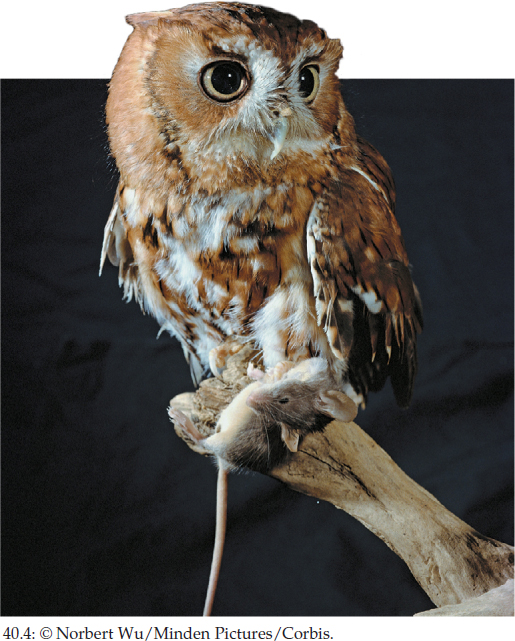Concept 40.2: Behavior Is Influenced by Development and Learning
The particulars of an individual animal’s life—such as the exact place it lives and the exact appearances of its parents—are typically not predictable. Information about these particulars therefore cannot be inherited. Biologists think this is the fundamental reason why animals have evolved the ability to learn—by which we mean the ability of an individual animal to modify its behaviors as a consequence of individual experiences that took place earlier in its life. Suppose that a mouse living in a forest is less likely to be caught by a predator if it can rapidly return to its burrow. Prior to the mouse’s birth, there would be no way to predict the location of that mouse’s burrow or landmarks useful for finding the burrow. For this reason, natural selection could not provide inherited information on these particulars. However, natural selection has favored the evolution of learning abilities. A mouse inherits mechanisms by which it can learn locations. Then, during its life, it uses those mechanisms to incorporate specific information on its actual burrow location and useful landmarks into its escape behavior.
Lee Metzgar did experiments on white-footed mice (Peromyscus leucopus) to test the validity of the idea that animals learn about their surroundings in ways that aid their survival. An important background point for understanding Metzgar’s experiments is that when these mice move around on the forest floor, they commonly run next to logs or sticks. An adult mouse was allowed to live for several days in a seminatural arena with a simulated forest floor, consisting of small logs, sticks, and dead leaves. There was no burrow in this room, but there were logs big enough to provide protection from aerial attack. Then the mouse was temporarily removed from the room and a hungry screech owl was introduced. Soon afterward, the mouse was returned to the room, along with a new mouse that lacked prior experience with the room. The arena was then observed until the screech owl caught one of the mice (FIGURE 40.4). To a strongly significant extent, the new mouse was the one more likely to be caught. However, if the logs, sticks, and leaves were replaced with new but similar items in different locations immediately before the test with the owl, the two mice in the room were equally likely to be caught. These results indicate that the experienced mouse learned the locations of logs and sticks during the days it lived in the room. It knew escape routes and places where it was safe, provided the logs and sticks were where the mouse had learned them to be.

Specific information of critical survival value is often learned during early postnatal development
Konrad Lorenz, one of the pioneers of the modern study of behavior, discovered that if he associated with young greylag geese (Anser anser) soon after they hatched, they thereafter treated him as if he were their parent. They associated with him instead of other geese and followed him everywhere. This attachment bordered on impossible to change. Lorenz named this phenomenon behavioral imprinting (not to be confused with genomic imprinting; see Concept 11.3). By now we know that imprinting occurs in many other species of birds and some other animals. Today behavioral imprinting is defined to be a type of learning that is distinctive because the learning takes place within a relatively narrow window of time early in postnatal life and, after that, is inflexible. Imprinting can have lifelong consequences. When male geese imprint on a person at the start of their lives, they later, in adulthood, prefer trying to mate with people. During normal development, geese imprint on—and establish a strong attraction to—their true parents and species.
831
Indigo buntings (Passerina cyanea) and some other bird species are noteworthy for navigating by the stars. As adults, the birds migrate at night, using the stars to determine the direction in which they fly. After this amazing phenomenon was first discovered, Stephen Emlen studied young buntings in a planetarium to learn more about the mechanism they use. Emlen established that the birds need to know the North Star to navigate correctly. But how do they know which star is the North Star? His experiments revealed that each young bird has to learn the correct star during its first few weeks after hatching. In the planetarium, Emlen could make the artificial sky rotate around any star he chose. Young birds learned to identify that star—the one the sky rotated around—and later, when they were under a natural sky, they treated that star as the North Star for the rest of their lives. When buntings develop outdoors in natural environments in the Northern Hemisphere, the sky appears to rotate around the true North Star (FIGURE 40.5). In this way, buntings in nature learn the true North Star.

Another type of early learning with enormous consequences—seen in many birds—is learning of species-specific songs. Darwin’s finches in the Galápagos Islands provide just one of many examples (see Concept 17.3). In adulthood, the males of each finch species sing a species-specific song that attracts females (which do not sing) in a species-specific way. The songs are not inherited, however. Instead, each male learns the song he will sing for the rest of his life during a period of about 30 days, 10–40 days after he hatches. During that period a young male is in or near his nest, and his father sings nearby. The young male learns his song by an imprinting-like process by listening to (and later duplicating) his father’s song. Particular brain regions, larger in males than in females, are required for this learning. If a young male’s father dies and he learns the song of a different species by hearing an adult of a different species sing during his critical learning period, the young male will later sing an incorrect song and attract females of the incorrect species.
Early experience also has other, more global effects on behavior
A large body of knowledge points to early experience as having multiple, intricate lifelong effects. These effects are specific to each individual, depending on that individual’s particular experiences. For example, an ongoing series of experiments on lab rats is bringing to light new revelations regarding behavior and early development. When they are carefully observed, rat mothers are found to exhibit different parenting behaviors. Two categories of mothers are recognized. Here we will call them “high-caring” and “low-caring.” Mothers in both categories are statistically the same in how often they nurse their young and in the absolute amount of contact they have with their suckling offspring. They differ, however, in how much they lick and groom their young during nursing and in how much they adopt a favorable posture for easy suckling. Mothers in the high-caring category lick and groom a lot and adopt a favorable posture. Low-caring mothers lick and groom to a lesser extent and adopt a less favorable posture.
832
Offspring of the two categories of mothers have been raised to adulthood and then studied in two potentially threatening environments that are new to them. In both environments, the adult offspring of low-caring mothers are far more likely to exhibit fear. For example, rats deprived of food for 24 hours were placed, one at a time, in a novel, brightly lit arena in which food was provided at only one place in the very center. This environment is intimidating because rats prefer low light and prefer not being out in the open. The behavioral differences between the two groups of rats were dramatic. Hungry adult offspring of low-caring mothers waited much longer than did hungry adult offspring of high-caring mothers to go to the food and start eating, and they spent far less time eating.
How can a young rat’s early experiences change its behavior throughout its life? In the case we are discussing, epigenetic effects are in part responsible and play a pivotal role (see Concept 11.3). Key regulatory genes in stress-response biochemical and hormonal pathways are tagged with epigenetic marks in early life. The tagging of these genes is different in offspring of low- and high-caring mothers. Such differences in epigenetic marking (which by definition do not alter the DNA itself) are maintained throughout the life of an individual, permanently altering the individual’s stress responses.
Malnutrition in early life is also known to affect epigenetic tagging in rats, as is abandonment. Marks from these early experiences persist into adulthood, altering gene expression and behavior throughout life.
In Africa, massive swarms of millions of migratory locusts (Locusta) sometimes form and fly across the landscape, causing devastation to crops wherever they land to eat. An amazing feature of this phenomenon is that each individual locust is capable of having two radically different behavioral phenotypes. One phenotype is that the individual avoids other individuals. A population of individuals expressing this phenotype is spread out and inconspicuous. Alternatively, each individual may be highly gregarious—meaning the population forms a swarm. Individual experience determines the phenotype. Individuals that are never forced to live closely together retain the solitary phenotype. The same individuals become a swarm if forced into close contact—for instance, if they are forced to feed next to each other, in the same places, because of food shortage.
CHECKpoint CONCEPT 40.2
- In captive breeding programs for whooping cranes, an endangered species of bird, the young birds must be prevented from seeing people because otherwise they will not mate with cranes. How can this be?
- Do epigenetic marks alter the sequence of base pairs in an animal’s genome?
- Penguins often breed in large groups in which nesting females are very close to each other, in contrast to some other species of birds in which nesting females are widely separated. Why might penguins have evolved particularly strong imprinting on their mothers?
Behavior is integrated with the other characteristics of animals. Next we will discuss a few ways in which behavior interacts with other aspects of animal function.